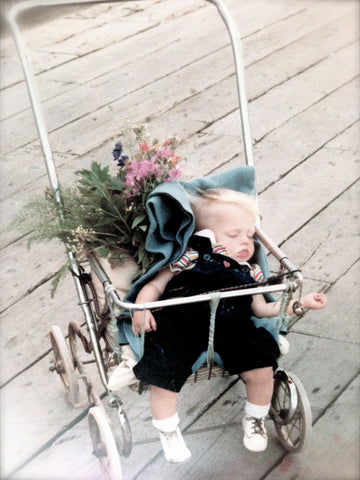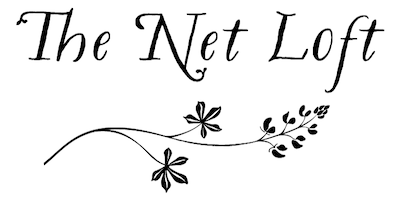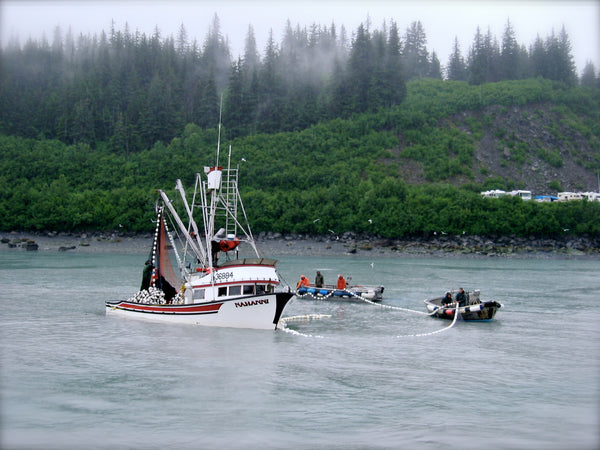Cordova Gansey Project: The Long Story - The Corkline #6 B
Share
6B: The CORK LINE
From Behind the Green Door with Felicity Ford to Beyond the Distant Shore
( a continuation of a LONG story starting HERE and most recently with 6A HERE)
Sitting down alongside my classmates around the table at Jamieson and Smith, I was overwhelmed by the tabletop piled high in yarn colors and choices of Shetland fingering yarn. I was so sorry to have missed the beginning, but with my morning adventure behind me, I jumped right in, with help thankfully from those seated on either side of me. Fortunately Knitsonik, Felicity Ford was still sharing and showing her examples and techniques for her Quotidian Stranded Colourwork.
Fantastic.
Felicity's excitement and enthusiasm was contagious.
Still hungry for an understanding of the "right way" to put colors together, I found it interesting that Felicity, like Stella, after presenting her process for developing patternwork, gave us the same type of opportunity to put this process into practice. With Stella, the day before, we had used a monochromatic format using texture as a means to interpret pattern, but now, with Felicity Ford we were instructed on the interpretation of a visual idea that incorporated both pattern AND color into the design.

This was about taking the past and letting it be an inspiration and guide for something new. A fresh perspective, a new vision, a new idea, a personalized version in the hands of the knitter.
The concept involved reflecting on the symbols and visual elements that held meaning to one personally, and taking those designs and elements and incorporating them into patterns in one’s knitting. In both of these classes, it wasn't just about studying and learning traditional patterns, copying them and integrating them into one's knitting, perhaps shuffling them around in different order, but rather, for me, it seemed to be starting from the questions,
- What do I love?
- What is important to me?
- What do I want to communicate through my design?
- What images define me or who I am going to knit for?
- What images in my surrounding environment resonate with me?
This is surely not a new concept, as patterns and designs throughout time have had such originations. Yet in my case, however, in love with the traditional and buried with life, I have ended up defaulting for the most part to traditional charts and designs. This is not to say that I haven't wanted to try something new. For years I have fawned over photos in certain books which align scenes and colors into knitting designs, such as Alice Starmore's Fair Isle Knitting, and deep down have wistfully yearned to do so as well.
And so, I was embarking upon a journey to a place I had longed for, but never made the time for. Now was my opportunity. The wrestle between what I wished I could do and what I ended up doing was no longer. I was in the right time and the right place with the right person being told to do something I had for years wanted to do, but only dreamed of. I have to admit, mixed with my excitement, I felt a little pressured, especially since I had arrived so late and I didn't want to "mess up" what I regarded in my mind as a special moment in time.

Like the day before, I was presented with yet another chance to be creative and to reflect upon a graphic interpretation of an aspect of my life and surroundings. Yesterday, In Stella’s gansey class, I had chosen the images of nets and fish. In Felicity’s workshop, I selected the cork line of a fishing net.
Another fisherknitter image, the corkline seemed a natural choice. The cork line: afloat on the waterline and of dire importance to fishermen for keeping the net buoyant and carefully secured in such a way that the net not only hangs correctly, but also comes back with minimal tangles.
As I began to experiment with ideas and chart my pattern on graph paper, I reminisced and reflected on the simple element and image of the cork line and it's meaning in my life. My mind drifted to the days before the shop, and to the fishing times after the birth of our first daughter and first child Rosemary.
This was the summer I didn't go fishing on the boat, and learned how to hang fishing gillnets from Bonnie in the APA net lofts. I was able to find an old wooden crate box that I lined with blankets and cushions, and there, as well as on a cushion on the warehouse floor, Rosemary slept while I worked on nets.


During that time, I remember the nice gesture of a dear wife and mom of father and son fishermen who lived in the bunkhouse who offered to take Rosie for walks now and then in an old stroller frame she had found and had put blankets in to make it more comfy.
She and Rosemary would stroll in this makeshift buggy along the wildflower lined road that went out to what is now Orca Lodge, and though unpaved at the time, it was a peaceful walk along the water's edge and allowed me time while Rose was awake to still keep working on the nets and would often be just what she needed to put her down for a nap.

When Bonnie started me out working on my first net, I was quite green and not famililar with gillnets as we had a seine boat and the nets are completely different.
I remember the instructions she gave me when I first started out. The net had to be hung "just so" she explained, describing its likeness in seamstress terms akin to a giant skirt of sorts. The distance between hangings and where you tied your knots was very critical and had to be so precise that if you were off by even a slight amount, the whole 150 fathom long net would be thrown off and the hang of the "skirt" would be affected, sort of like a knitters gauge and its effect on the final dimensions and fit of a garment.
Fishermen have formulas for their net hanging and these vary from fisherman to fisherman. I had to be very careful lest when the net was reeled in it would roll up or wind on improperly and I would be to blame, as it could cost the fisherman time and money.

Hanging and repairing fishing nets is an art and craft of itself. Even now, most of this work is still all done by hand. At the time I learned on a board that had markings along the surface to determine the spacing, but it is also done on a hanging bench. This NET HANGING VIDEO taken this spring of my daughter and her husband will give you a quick glimpse of both methods. It is a handcraft of rhythm and repetition, not unlike knitting.
The nets catch the fish, but the cork lines allow for buoyancy, aligned vertically by the weighted leadline. I thought about that which is necessary in my own life to provide structure and shape to my goals and dreams, and that which holds me up and provides buoyancy in an ordinary life that sometimes feels adrift or sinking. Without the cork line the net is just a heap of mesh.
Sometimes life gets full and just like a full net, the corks begin to sink from the weight of the load. During these times friends come alongside and keep the net from sinking and spilling the fish, as friends help us stay buoyant when life pulls us under. What would we do without friends.
As I continued to chart out different ideas for my cork line image that day with Felicity, my mind continued to conjure up these pictures of the past and I could almost hear Networker Bonnie's voice gently speaking to me as I filled in the boxes on the knitters graph paper provided for the class. It had been interesting that this trip and this time when I was off and so very far away so rekindled these memories encapsulated in these simple images such as the cork line and the nets.
With this added element of color to contend with, I began to swatch my charted design. To me, one of the most helpful things Felicity shared was about the value of swatching, and that it was important to remember to just keep trying different combinations and to experiment with them until you liked the results, and especially to not be discouraged by unsuccessful attempts. All of the attempts were an important part of the process.

As Felicity said and showed us in her swatches, sometimes designers may only show you a small part of their swatch and only the one that worked in the end, and you don’t see all the attempts made before they got there. For me this meant you have to start somewhere, with an idea and be willing to flounder a little before getting it right, and that thought held with me as I ventured into thinking of this gansey project that was taking form in my mind.
I thank Felicity for the thoughts she shared and for these reminders, as sometimes I can feel discouraged and lose confidence. I jotted down these quick notes around the borders of my charted design as I listened to her talking.
- doesn't have to be perfect from the start
- don't give up... keep trying different things and different ideas
- the WHOLE swatch with its seeming failures and multiple attempts has value
- EVERY ATTEMPT IS IMPORTANT TO THE FINAL DESIGN.
- ALL attempts are part of the process and the only way through it or to get to where we want to go or end up is to swatch and swatch again

As I looked at Felicity holding up her long swatches (she had a wonderful stack of them), which of course to me looked delightful as a long collection of pattern and color and design, I thought that perhaps with some of these attempts we might think we don't like, in the big picture, incorporating some of them may actually make the final design more interesting. Therefore, in these swatches it seems important to keep going and not take out everything we think we don't immediately care for, and how it helps for us to visually see everything right next to each other, good and not so good, just for comparison, so we can clearly see the difference of what works and what doesn't so much.
I loved hearing this and instantly thought of this "messy" life of mine where I have so many attempts that seem inferior in so many aspects of my life, and it is easy to lose perspective and feel discouraged instead of seeing the big picture. Again, it is ALL important, and it ALL has value. As far as this developing gansey project, it means that we will have to get in there and get started and be willing to experiment and try new ideas, and some ideas and attempts may not be as successful as others, but that is ALL part of it.

And so I left with my not so perfect cork line image, sketches, and swatch, and a reinforcement of the concept of the integration of lifestyle and handcraft, fishing and knitting. The corkline image was my connection to all fishermen throughout the centuries; a particular element relevant to our fishing family in our present lifetime as well. It is an image I hope to develop and keep working on, and eventually incorporate into a color and patternwork piece. And more colourwork understanding is where I was headed next, to a fair island rich in mariner and color knitting history.
My question for you is, what images resonate and tell your story, and as I heard once from a weaving instructor, I believe it was Anita Luvera Mayer, "there are over 10,000 mistakes to be made in weaving, so you better get started." Same applies all around to a lot of things... wouldn't you say?
Enough for now...Off we go... more to come...
Thanks to Felicity Ford for an encouraging and inspiring workshop.
Felicity's Book KNITSONIK COLOURWORK & SOURCEBOOK is wonderful, and in stock at the shop, and may be purchased onlne at The Net Loft via THIS LINK.
NetHanging Video courtesy of Drifters Fish Co
Piet Klaasse "Gillnetter" Watercolor used with permission from Artists for Nature. Thank you, Ysbrand Brouwers
The Long Story continues...Chapter #7 link













4 comments
Thanks Marilyn, Megan and Kirsten for your comments. I am afraid I have been under water so to speak with fishing season and all that entalls with associated family fishing life, summer shop flurries, gansey get togethers, and pile sorting. I hope to pick up and finish the story soon. Stay posted! I will be back at it soon enough.
I absolutely loved reading your Gansey story! So inspiring! I can’t wait to see the beautiful knit creations that will come out of Cordova, and I can’t wait to hear more!
Ah, Alaska and yarn – a perfect match – whether a long story or something to work with in your hands! You have also inspired me to perhaps take a trip to the Woolfest, also traveling from our west coast. Thanks for sharing your experiences. M